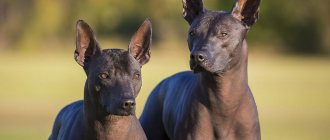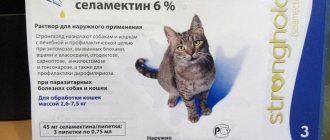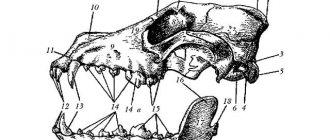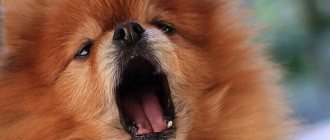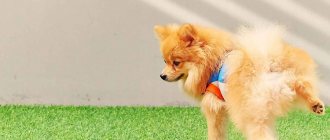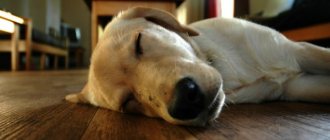Why should they be installed?
It is necessary to put ears on dogs so that the pet does not raise doubts about its elite status. Erect ears give animals a more aesthetic and impressive appearance. This issue is especially important for exhibition animals.
If the identified defect of lop ears is not a congenital defect and was not obtained as a result of injury, then simple manipulations will help correct the situation (in other cases, the help of a veterinarian and surgeon will be required).
Some dog owners do not consider ear studs necessary. Moreover, the standard of many breeds allows them both standing and hanging positions. In any case, the choice remains with the person, and the dog is completely indifferent to what ears it has, because this will not affect its devotion and love.
What are the types of erect ears?
The first step is to understand the concept of “prick ears”. So, they are divided into two types: docked and not docked.
These puppies are born with small, floppy, triangular-shaped ears that naturally stand up on their own. In different breeds of dogs, the ears take on a standing position at different times.
For example, husky puppies at 1.5 months already have erect ears and have practically no problems with this. German and East European Shepherds can boast erect ears closer to 4 months of life, and Yorkshire Terrier puppies have erect ears at approximately 2.5-3.5 months.
Puppies whose ears are cropped are born with large, floppy ears that are oblong in shape. Prominent representatives of this species are: Doberman, Great Dane, Miniature Pinscher, Giant Schnauzer. The ears of these dogs never stand up on their own.
Following breed standards, their ear flaps are surgically shaped into pointed triangles of varying sizes. The docking operation is performed on puppies that have reached the age of 2 months under general anesthesia.
Cropped ears absolutely require staging and gluing. This procedure is lengthy, because such a puppy was not naturally designed to have erect ears.
If the ears have been in a hanging position for a long time, then they may have kinks in the cartilage, which can damage their quality after cropping.
Why they don’t get up - reasons and solutions
Newborn puppies are born with small ears pressed to their heads. As the animal grows, they straighten out, the cartilage strengthens and they take on a vertical position.
The time has come, but the dog’s ears don’t stand up. Why? The answer to this question is often of great concern to owners. The process of ear raising is influenced by five main factors:
- Genetic inheritance.
- Unpurebred (mixed puppies).
- Lack of calcium in the body.
- Too thick (fleshy) ears.
- Thin and weakened.
The main thing is not to panic and not to give up. Problematic ears need human help and can be fixed. The set of activities includes:
- proper nutrition;
- special vitamins;
- manual massage;
- ear gluing.
Nutrition
If the puppy's diet does not have enough calcium, or he did not get enough of it through his mother's milk, his ears may droop. In this case, you need to review your pet's menu.
Small breed puppies born from bitches who have suffered from postpartum eclampsia (loss of calcium in the blood) will most likely have problems with ear placement!
You can add calcium to your dog’s body using natural goat’s milk or calcium-enriched cottage cheese. It is not difficult to prepare it at home.
Recipe for making calcined cottage cheese
Edible gelatin, which can be added to the puppy’s food or prepared aspic dishes based on it, will help your dog replenish the lack of calcium.
Excess calcium in a pet’s body is no less dangerous than its deficiency. In this regard, it is important to comply with the daily norm of its consumption.
Vitamins
To strengthen cartilage tissue, special vitamins should be added to the puppy’s main diet: Excel, Polydex, Canina, Beafarm, Calcefit, Volmar, Kanvit. Vitamin “Steed Plus” is good for lifting weak ears, but it is quite expensive and you can’t buy it in every store.
“Silver Trail” Calcium Peptide is a little-known Russian brand. Its natural composition and nano-method of supplying calcium to the bone and cartilage tissue of animals receive the highest marks from experts.
Before purchasing and using zoovitamins, you must consult a veterinarian.
Massage
Massage is an additional measure to solve the problem of drooping ears. It helps in combination with nutrition and vitamins. It is not difficult to do, and the dog perceives the massage as if it were affection.
During this time, the puppy should not be distracted and should be completely relaxed. Grasp the base of your baby's ear with your thumb and index finger. Using kneading massage movements, work the cartilage itself and move towards the tip, slightly pulling and directing the blade vertically. Perform several massage techniques at once in this way.
The massage will not harm the ears and the number of procedures during the day is unlimited . Thanks to it, blood flow increases in the tissues, which has a beneficial effect on the process of strengthening and maturation of cartilage tissue.
Breed Features
Huskies are luxurious and well-built animals.
They are distinguished by special restraint and self-esteem. But this does not mean at all that dogs do not like to frolic and play with their brothers. By the way, they will not leave their owners unattended, even on walks. After all, huskies are very attached to “their” people. This is how it happened historically. In ancient times, animals warmed people and their small children with their warmth on cold evenings and nights. Therefore, huskies are excellent, caring nannies and will be able to find contact with any child. But a dog of this color is unlikely to be suitable for hunting. Of course, the hunting instinct of these pets is enviable. But, having caught game, do not expect the dog to bring it to you. Most likely, she will dine on the prey herself.
As for external characteristics, huskies are medium-sized dogs, with thick hair and dense undercoat. A distinctive feature of this suit is a special mask on the face and a non-standard eye color, most often bright blue or brown. But the most popular lucky dogs are considered to be harlequins (dogs with multi-colored eyes).
In addition, animals have a tail curled into a ring in the active state, which can be lowered in rest mode. As for the ears, they are completely erect. Creases and bends are considered defects or deviations associated with a lack of nutrients in the body.
Bonding - pros and cons
The “gluing” method helps to radically make your puppy’s ears droop. It has proven itself in practice and is widely used for installing cropped and undocked ears on various breeds of dogs.
Some pets behave excitedly after gluing. They try to rip off the bandage and the structure with their paws, and rub their heads against the furniture. This way they can damage the ear cartilage and make the situation worse. In this case, you should loosen the tie and wrap or put on a special protective “collar” for the puppy.
Sometimes, after removing the adhesive plaster, an allergic reaction, pimples or scratches are clearly visible on the ears. Suitable for their treatment:
- baby powder;
- hydrogen peroxide;
- pharmacy blue.
After the ears have rested, the wounds have healed, and the crusts have dried, you will need to repeat the gluing procedure.
The “gluing” method is completely safe for the physiology of the animal and has no contraindications. This procedure should be carried out carefully, observing all preparatory and main steps.
Causes of the problem
When a husky puppy’s ears stand up, the following factors may interfere with the process:
- Heredity (when purchasing a puppy, you need to familiarize yourself with its pedigree, find out whether the dog’s ancestors had ear problems).
- The animal’s well-being (weakened immunity can cause the ears to fall off).
- Diet (the puppy’s diet should contain enough vitamins and microelements for its proper development).
- The degree of activity of the pet (insufficient activity negatively affects the development of bones and cartilage, excessive activity causes overwork, which also has a bad effect on appearance).
- Vaccinations can also negatively affect the condition of a dog's ears.
- Stress.
During the period when the husky's ears stand up, the replacement of milk teeth with molars may begin. At this time, even erect ears can fall and remain in a hanging position for up to six months.
So, what time a husky’s ears stand up depends on various reasons. By eliminating the obstacles that have arisen, you can speed up this process.
Staging methods
Ear fitting for dogs is carried out using soft and hard structures. Both methods have the same goals and similar execution techniques, but differ from each other in the materials used.
Rigid design
The rigid design is used for large dog breeds and long cropped ears. You can make it yourself from scrap materials or buy it at a pet store. To create a basic hard “crown” you may find it useful:
- foam rollers for the liner;
- medical glue will help to glue the curlers;
- a pencil so as not to get your hands dirty;
- Popsicle sticks for rigidity and as a guide line;
- General fixation will require medical or surgical tape. Reinforced construction tape or masking tape will also work.
Make sure that the glue does not get into the animal’s ear canals and do not forget to first remove hair from the ears and degrease them with an alcohol solution.
Soft design
This setting option is suitable for small breed puppies. It provides for gentle gluing without glue or complex rigid fixations. Making gluing using a soft structure is not difficult.
The necessary materials are a 3 cm wide adhesive plaster and cotton swabs (for rigidity). As in the first case, the fur from the ears must be shaved off and the ears wiped with alcohol, otherwise the procedure for removing the adhesive tape will cause pain to the puppy.
There are many options for gluing and setting ears. Any materials can be used: sanitary tampons, cut-outs from plastic cards, pen refills, plastic bottles and foam sponges.
The main rule is do no harm. It is important that the devices do not injure the puppy, are durable and light, so that they are easy to install and not difficult to remove.
How to train a dog to clean its ears?
Correct and effective cleaning of dog ears is only possible if the animal itself is favorable to the procedure. In this case, it will not spin around or try to escape.
It’s easy to accustom your pet to regular ear cleaning:
- For the first few cleanings, make sure your dog is fed, walked, and in a good mood. If your pet is not feeling well or is sick and ear cleaning can wait, reschedule it for a more convenient time.
- Talk to the dog in an even, calm tone, pat its withers, or perform any action with which you usually approve or praise your pet.
- Sit down and have your dog sit in front of you - for the first time this can be done comfortably by placing your pet between your knees and squeezing him lightly. Make sure you have everything you need on hand - tampons and discs, ear cleaning lotion.
- Carry out cleaning carefully, making sure not to hurt the dog with careless or too strong movements.
- After completing the procedure, praise your pet and treat him with a treat.
Step-by-step instructions for installing undocked ears on small dog breeds
All small and decorative breeds have the same way of setting problematic, undocked ears. Let's consider it using the example of the Chinese Crested Dog, whose ears can be set on the 21st day of life. To do this you will need:
At the base of the auricle there is a delicate septum. Work carefully, ask another family member to help you, fix the pet's head . The noise and vibration of the machine can frighten him.
- Shave the hair on both sides of the ears with a trimmer. This will reduce their severity and ensure painless removal of the adhesive plaster. Remove any remaining fur from the edges with scissors.
- Wipe the ear with alcohol or any degreaser to make the patch stick better.
- Cut a piece from the adhesive plaster that is the length of the ear and place it on the table with the adhesive side down.
- Cut half a cotton swab and place it on the adhesive plaster.
- Place the second and third layers of adhesive tape on top of the cotton swab.
- We cut out the resulting strong sizing according to the shape of the ear, with the cotton wool facing down, and glue it to the inside of the ear, so that the ear canal is visible.
- We wrap the ears like a tube, but not too tightly so that the animal is comfortable.
- We wrap the folded ear at the base of the cartilage around the circumference with adhesive tape. Do not bring your ears close to the top of your head, as this may cause them to be positioned incorrectly. The bandage should look natural.
- To prevent the ears from falling apart in different directions and leaning forward, they will need to be fixed horizontally. They need to be connected to each other so that they are vertical. We connect them with adhesive tape at the base.
The puppy needs to stay in this bandage for about 5 days. Then the patch is removed, carefully unwinding it and trimming the hairs of the fur with scissors. It happens that after the first gluing procedure the ears already stand up.
If the result of raising was not achieved, then after a 12-hour rest the ears are glued again in the same way until they become stronger and take a vertical position..
The Chinese Crested Dog has two varieties: hairless and powder coated. The ear placement pattern is the same for both. According to the standard, the hairless variety must have erect ears, while the puffer variety is allowed to have both erect and hanging ears. According to breeders, a puff with erect ears looks more impressive.
How to strengthen ear cartilage
What to do if your puppy's ears don't stand up? The program of action depends on the health and maintenance of the pet. Let us outline its main directions.
Diet optimization
Most often, the problem of “ear growth” occurs due to improper organization of natural nutrition. It is impossible “by eye” to guess the correct dose of healthy products (cottage cheese, sour cream, cartilage) that supply the body with calcium and other important “building materials”.
To compensate for the deficiency of substances responsible for the formation of connective tissue, you first need to examine your pet, and then create a balanced diet. This matter cannot be accomplished without the help of veterinary service workers. There is always a risk of overfeeding with them instead of compensating for the missing components.
But after visiting the clinic with a German Shepherd puppy whose ear has fallen off for some reason, all doubts will be eliminated. The specialist will “adjust” your four-legged friend’s menu according to all the rules of nutrition: with high-quality mineral and vitamin supplements and fiber-forming ingredients. A balanced diet in tandem with a massage will quickly solve the problem.
Gluing
This radical procedure is used to lift and strengthen a “heavy” ear that is twisted, wobbly or drooping. Most often, this affects large puppies with poorly developed muscles and massive ears, forming an obtuse angle at the base.
There are several ways of gluing that will allow you to put on your puppy’s ears:
- Using special veterinary glue Tear Mender or Cherry Knoll Ear Fix (can be replaced with less expensive but safe Bison Textile). You need to apply glue to the upper inner part of the ear plate, fold it in the desired position and hold it until it dries completely for 1-3 minutes.
- Fastening with adhesive tape. Cut small squares from sticky tape. One of them is glued to the inner surface of the hearing organ, at the base of the cartilage. The rest are fixed over him. Then a splint (an ear stick, a cotton cylinder, a roll of gauze) is inserted along the glued strip of plaster and secured with a second layer of plaster squares. To keep the ears parallel, a bridge is fixed between them.
- Installation of wire “crown”. It is better to purchase this device at a pet store and place it on your pet’s head for several weeks. Making a wire frame yourself is labor-intensive and requires skill.
Before manipulations, the ears should be freed from fur, cleaned and degreased. In order not to cause an allergy, you need to experiment on a small area of skin: apply an adhesive agent to it and wait 2-3 days for the reaction. If the patch or glue turns out to be allergenic for the animal, you can replace it with surgical tape.
Typical mistakes when modifying the ears:
- fixation too tight;
- production that does not meet the breed standard;
- introduction of infection;
- injury to the skin when removing the patch (to avoid this, the overgrown hair should be cut off along with the adhesive tape).
In order not to harm your pet, it is better to get acquainted with the progress of the procedure using a video that will clearly show the master class.


